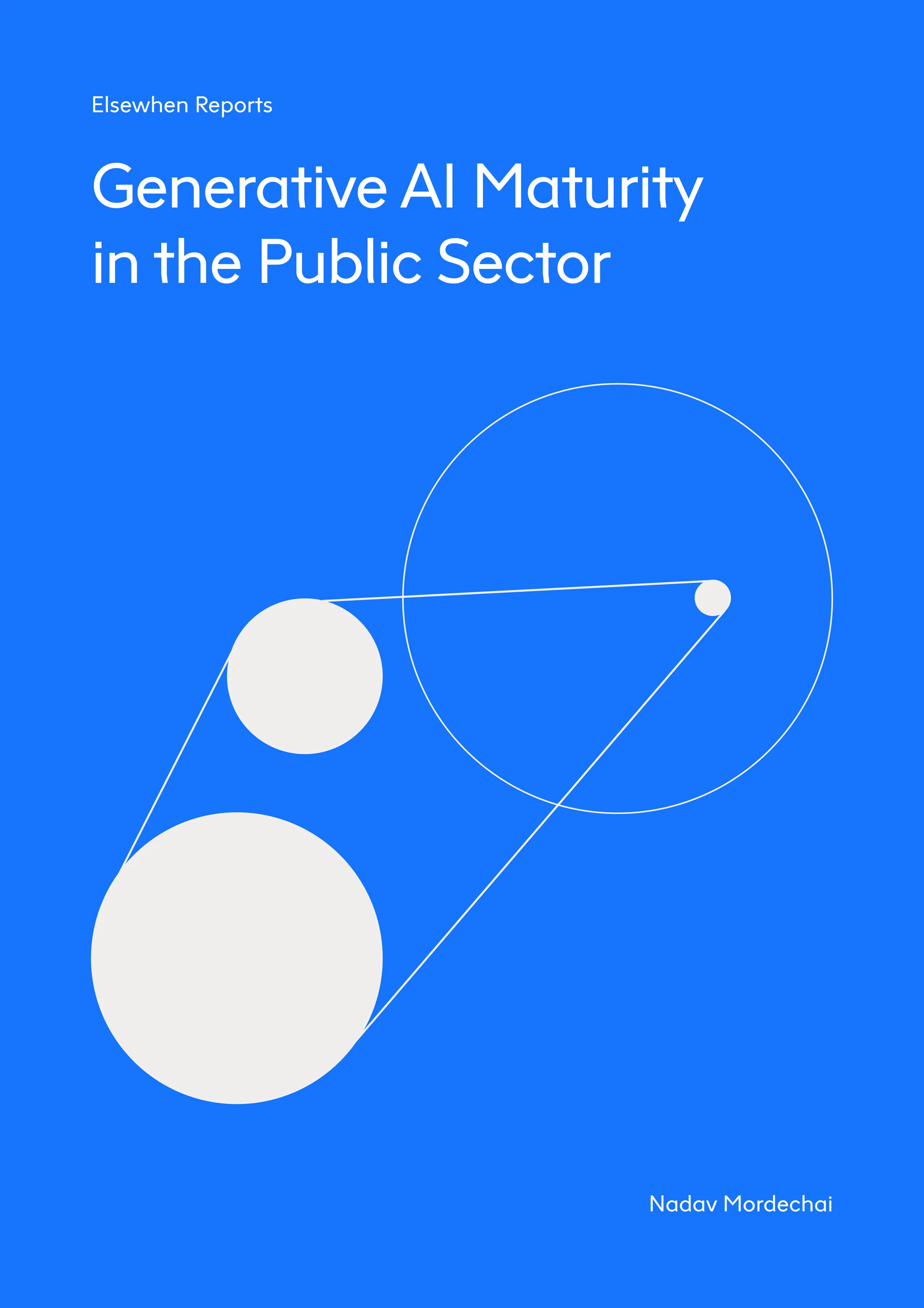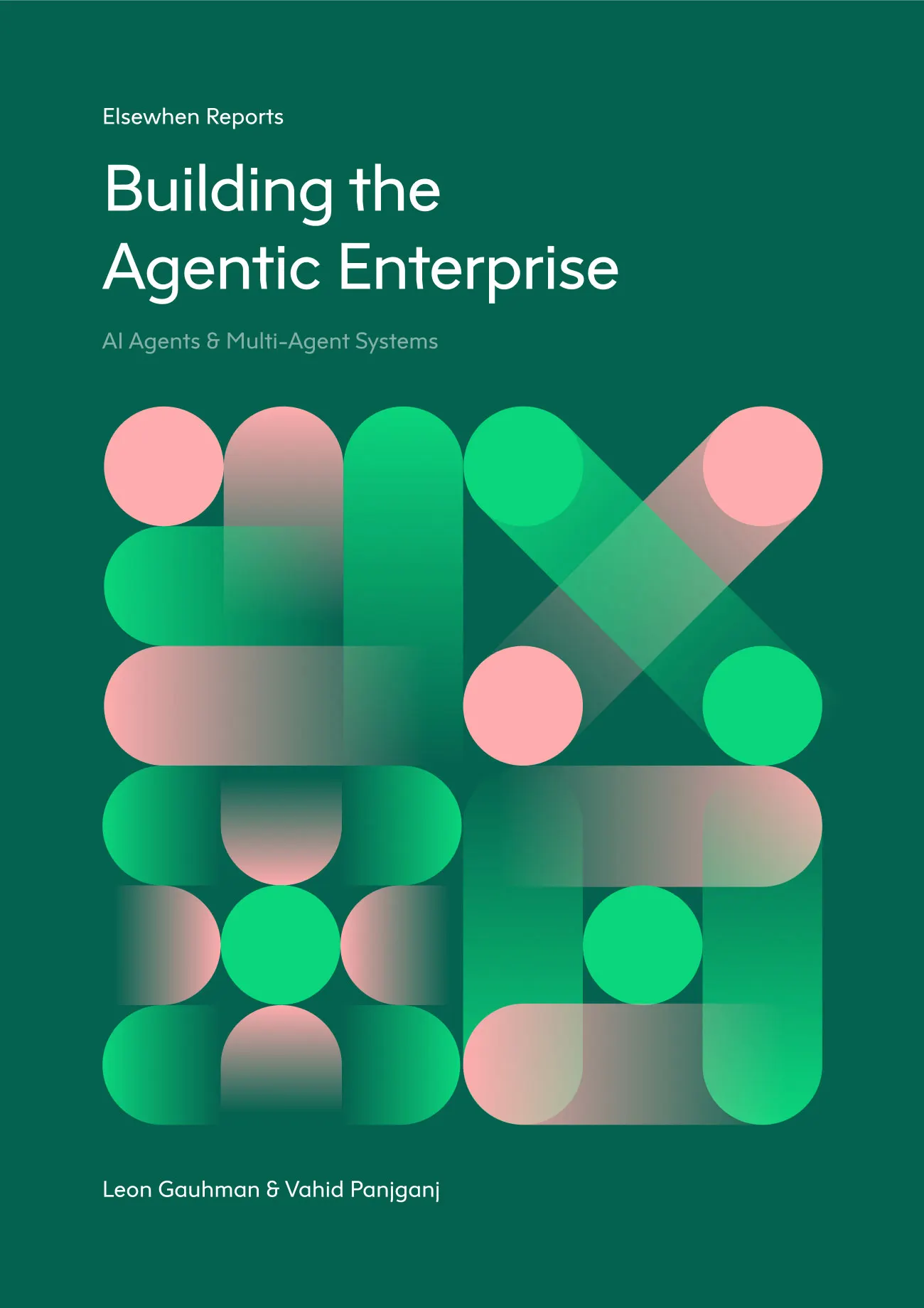
We’ve entered the Intelligence Age — and at the heart of it is a new kind of system: the AI agent.
Agents don’t just assist; they operate. They plan, act, adapt, and make decisions, not because they’re told to, but because they’ve learned how. They’re moving beyond APIs, navigating interfaces, using tools, and working alongside us, or without us.
On Planet Agent, you’re not just adding AI to your systems. You should be building systems where AI is the system. From finance to pharma, satcom to construction, entire workflows are being handed over to AI agents that reason, execute, and evolve.
The implications are profound. Not just faster work, but a complete replacement of work. This isn’t some distant scenario, it’s already unfolding.
Let’s look at how different verticals are beginning to adapt to this new world.
Satcom
Aerospace
Telecommunications
Financial Services
Pharmaceutical
Media & Advertising
Construction
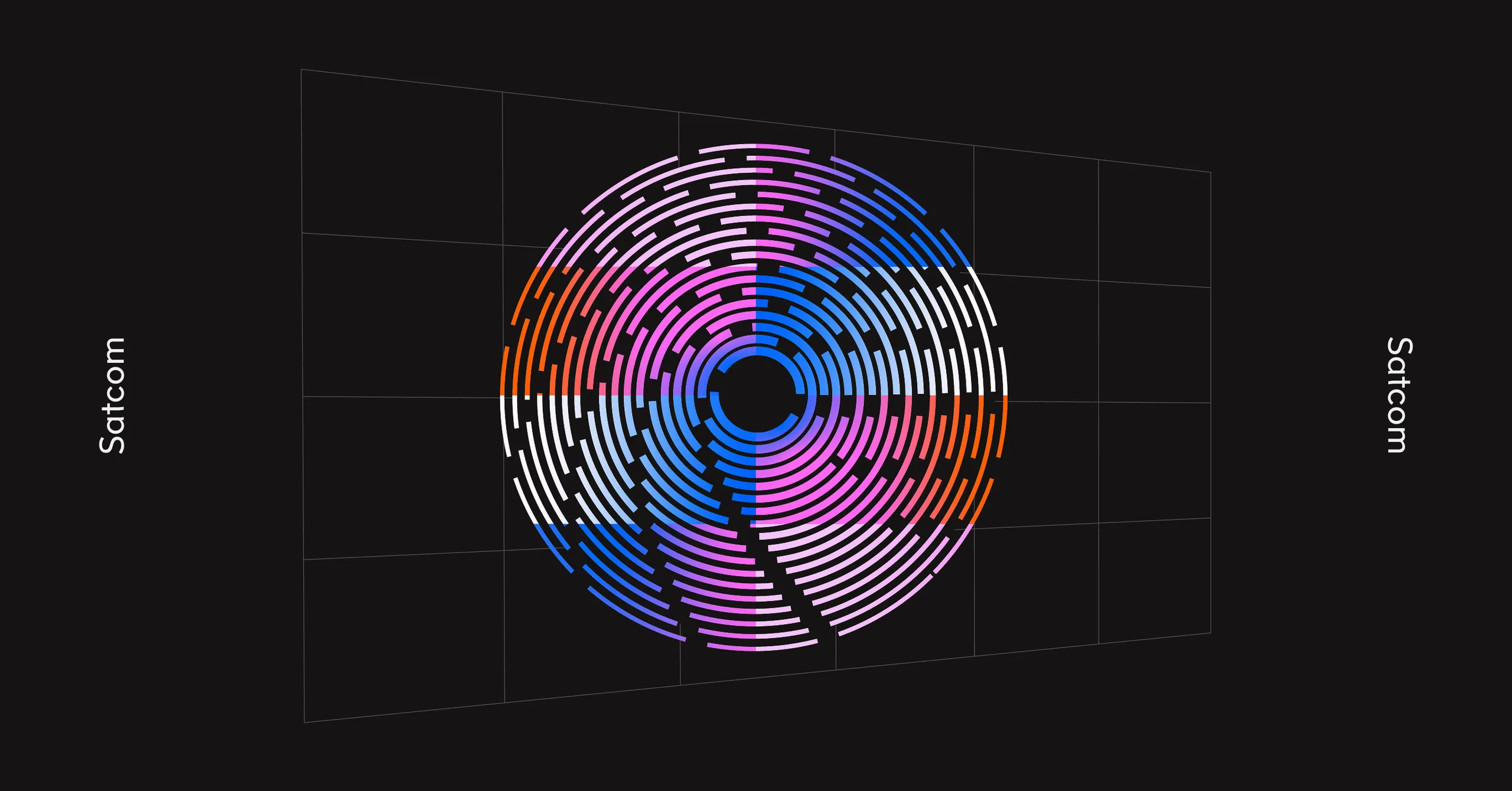
Satcom
Overview
The satellite communications sector is entering its next operational era. With over 7,000 satellites already in orbit — and constellations like Starlink and OneWeb rapidly expanding — complexity has scaled beyond human coordination. Orbital congestion, shifting signal conditions, and rapid inter-satellite handovers are now the norm — not the exception.
Modern satellite networks are moving toward intelligent control architectures where AI agents continuously interpret telemetry data and act autonomously. These systems route signals, mitigate interference, and allocate bandwidth dynamically — adjusting in real time based on demand, weather, and orbital positioning.
As with much of aerospace infrastructure, these systems are inherently dual-use — straddling both civilian and defence applications. In such contexts, agentic autonomy doesn’t just improve operational efficiency; it reshapes control, accountability, and the strategic calculus of space.
In this environment, agentic AI is emerging as the new operating layer — raising not only questions of coordination and performance, but of sovereignty, as autonomous systems begin making decisions traditionally governed by national or institutional control.
This shift is being architected in two directions. Inspired by telecom’s Cloud-RAN model, centralised ML-based control planes give satellites a global network view. At the same time, as compute moves onboard, edge processing is enabling local, low-latency decision-making — from autonomous anomaly detection to adaptive beamforming.
This shift isn’t hypothetical. According to recent research, 65% of Satcom providers are now testing AI for dynamic routing and congestion control, and over 40% are exploring onboard inference for in-orbit autonomy.
Elsewhere, multi-agent systems (MAS) are being deployed to autonomously manage signal routing, power allocation, and reconfigure network topology in real time. In one simulation on real Starlink and Kuiper architectures, an agentic system called SATFLOW reduced operational costs by up to 89% and improved throughput by over 10%, compared to traditional approaches.
In a domain where velocity outpaces human reaction, agentic AI is no longer optional — it’s foundational.
Key Applications
Autonomous Satellite Networks
Cybersecurity & Anti-Jamming Operations
Predictive Network Traffic Management
Intelligent Signal Processing & Beam Optimisation
- 89%
- Reported reduction in operational costs via Multi-Agent AI Systems (MAS).
- £3.7B
- Investment by the U.S. Space Force into AI-powered SATCOM systems — targeting 99.999% uptime for strategic communications by 2026.
- 28M
- Global number of agricultural sensors supported by AI-optimised SATCOM transceivers, boosting crop yields by 17% through precision farming.
- £57.7B
- Projected size of the SATCOM-on-the-Move market by 2029, growing at 20.3% annually.
Key Challenges
Despite rapid gains, agentic AI in space still faces hard limits.
Power remains the first ceiling. Onboard machine learning is still rare, largely due to the energy and redundancy demands of AI hardware in space. Most satellites today operate in passive relay mode — frequency conversion only — avoiding the draw and complexity of real-time onboard intelligence.
Data is the second constraint. Even with pre-trained models, inference can be brittle when unexpected system states arise. Training in-orbit would unlock adaptability — but current power and memory budgets don’t allow it. Meanwhile, most communications still operate at the bit level, creating a bottleneck that makes transmitting full datasets back to Earth costly and slow.
Compute trade-offs are the third constraint. Autonomy in orbit demands more than just power — it requires models and chips designed to prioritise meaning over noise. It’s not about sending every bit of data with perfect fidelity (technical accuracy), but about transmitting what’s relevant to the task. That shift — from fidelity to semantic relevance — requires co-optimised architectures and smarter communication.
The Internet of Space (IoS) — a vision for interconnected, intelligent satellites that collaborate and share only high-value data — is gaining momentum, but without shared standards or performance baselines, progress remains patchy.
“In the past, we have insisted on ensuring that autonomous space systems always include a ‘human in the loop’. During 2025, I suspect that we will begin to question decisions that have not been vetted through AI reasoners. For important decisions, we will stop asking whether there was a human in the loop and begin to insist on 'having AI in the room'."
Dylan KeslerDirector, Machine Learning and AI, Slingshot Aerospace
The Elsewhen View
Space for Impact
AI agents are quickly becoming the control layer for orbital infrastructure — coordinating traffic, reallocating bandwidth, and adapting in real time to changing signal and weather conditions. As satellite data traffic accelerates toward 0.13 zettabytes annually, the complexity of managing next-gen constellations is surpassing human response time.
Agentic systems absorb that complexity. They enable constellations to detect anomalies, reroute traffic, and reconfigure beam patterns without manual input. They enforce encryption protocols, manage spectrum allocation, and simulate congestion before it happens.
In a sector defined by latency, risk, and scale, agents provide the responsiveness and resilience needed to deliver uninterrupted global coverage. The future of Satcom will not be built around control centres — it will be built around coordinated intelligence.
Who's Doing it? Italian startup AIKO raised a €3.5 million Series A in late 2024 to accelerate its mission: building autonomous agents for space infrastructure. As the “first European company to deploy deep learning algorithms in orbit”, AIKO specialises in agent-based systems that handle everything from onboard manoeuvring to anomaly detection and payload data processing.
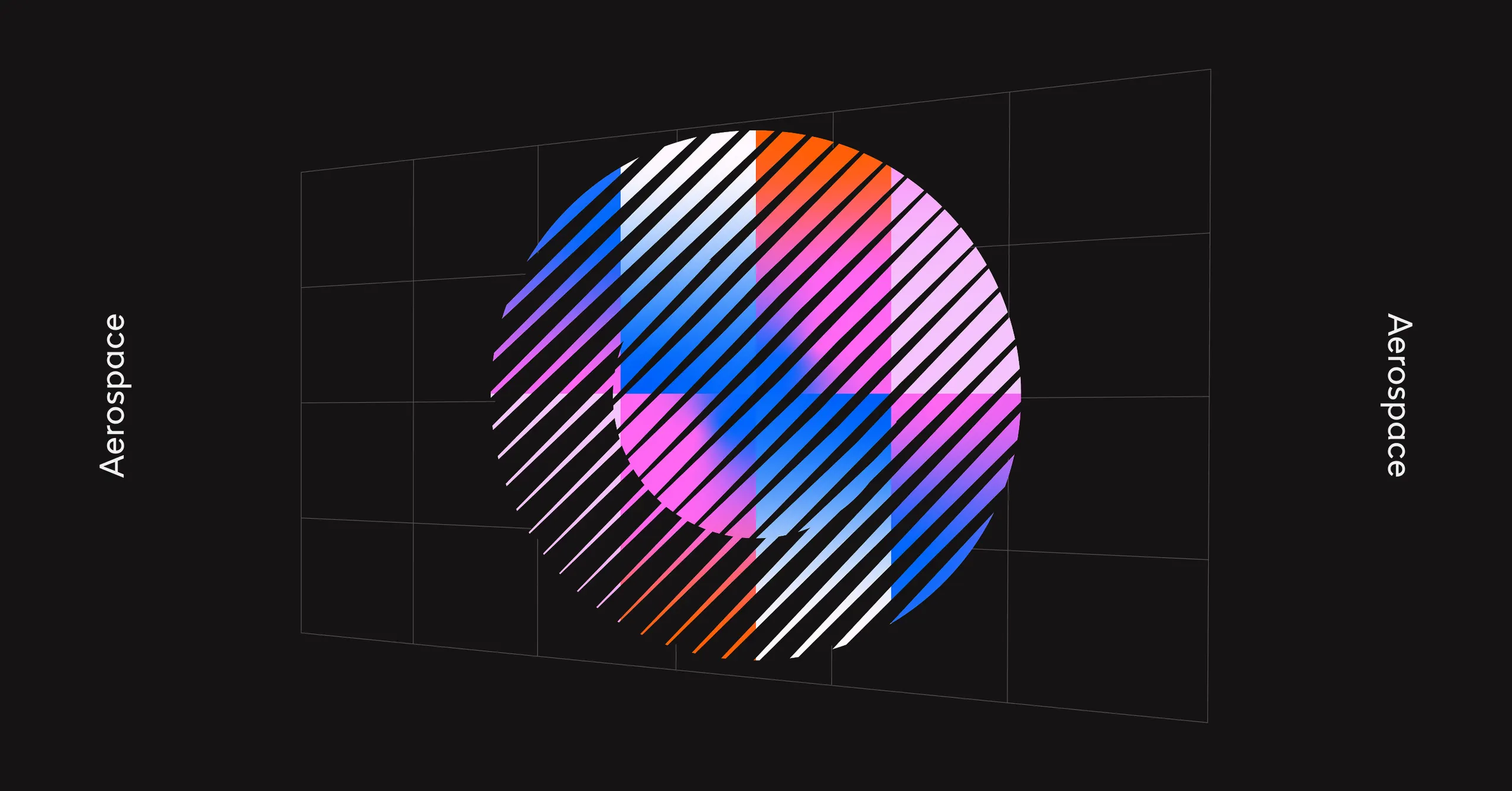
Aerospace
Overview
Like Satcom, the Aerospace sector is entering a new operational era. AI agents are no longer limited to decision support, they’re also assuming autonomous control across design, production, and flight.
This shift is being driven by systems that fuse real-time sensor data, predictive analytics, and adaptive control algorithms. In an industry where safety margins are razor-thin, autonomy isn’t a luxury, it’s becoming a necessity.
According to one report, airlines are prioritising Generative AI for route optimisation, disruption management, and real-time customer support. These aren’t abstract ambitions: some carriers are already using AI systems to model traffic, weather, and even geopolitical risks to dynamically reroute flights. Others are integrating agentic tools to personalise rebooking and rerouting during disruptions — particularly for vulnerable passengers.
Alaska Airlines’ Flyways system, for instance, reduces fuel burn by over 6% through dynamic route optimisation. Elsewhere, Google teamed up with airlines to help pilots reduce contrails by 54% (contrails account for roughly 35% of aviation's global warming impact) by developing AI-driven contrail forecast maps.
Even upstream, AI systems are reshaping design. Scientists have developed a new class of nanomaterials using AI and 3D printing that are as strong as carbon steel but lighter than styrofoam. These innovative structures more than double the strength of previous designs and could lead to significantly lighter, more fuel-efficient components for aircraft and vehicles.
Not all of these systems are agentic in the strict sense — many remain assistive or model-driven — but the trajectory is clear: AI is embedding itself across operations, optimisation, and even material innovation.
Key Applications
Autonomous Flight Systems
Generative Design & Additive Manufacturing
Predictive Maintenance Ecosystems
Pilot Assistance & Error Mitigation
GPS-Denied Autonomy for Defence Systems
Automated Air Traffic control
- £34.12B
- Projected size of the global AI aerospace market by 2030.
- 600
- Reported agent use cases identified by Airbus in the first year.
- £1.34B
- The global AI-Based predictive maintenance market grew value by 2030.
- 25–30%
- Cost reduction in manufacturing costs for aerospace components achieved through AI-driven process optimisation and generative design tools.
Key Challenges
Adoption of agentic AI in aerospace still faces three core challenges: regulation, data, and trust.
The first is regulatory complexity. Aerospace systems face intense scrutiny, especially in safety-critical roles. Initiatives like the EU’s SESAR programme require explainable, certifiable AI — slowing deployment even when performance is strong.
The second is fragmented data. Predictive maintenance, autonomous routing, and real-time optimisation all depend on high-quality inputs — yet much of the sector’s data remains siloed across legacy systems. Without clean, structured data, agents can’t operate at full capacity.
The third is human trust. In roles like piloting and air traffic control, AI adoption is often met with resistance. Here, the human-in-the-loop remains essential — not as a backup, but as a partner in high-stakes decision-making.
Progress is being made. But industry-wide change depends on clarity, collaboration, and systems designed to enhance — not necessarily replace — human expertise.
“What these agents are actually doing is decision making with uncertainty.”
Richard CannonNATS researcher on Project Bluebird
The Elsewhen View
Margins over Moonshots
As in other high-risk industries, aerospace innovation begins not with moonshots, but in the margins — in inspection bays, in customer support systems, and across the supply chain. That’s where AI is already delivering impact. Not by replacing humans, but by creating faster feedback loops between intelligence and action.
Airlines like United are using generative AI to interpret decades-old labour contracts, flag real-time customer issues, and even anticipate rebooking needs before passengers call. Southwest is automating marketing and messaging.
Meanwhile, IAG — parent company of British Airways, Iberia, Aer Lingus and Vueling — is going further, embedding AI across its operations through a dedicated Chief AI Scientist and newly established IAG.ai labs in London and Barcelona. These hubs are developing systems for predictive maintenance, route optimisation, real-time weather forecasting for pilots, and personalised virtual assistants for customer service.
While not all of these AI systems are fully agentic today — many are crossing the threshold. At the other end of the spectrum for instance, Shield AI’s agents have flown military aircraft like the X-62A VISTA — not in simulation, but in the real world, with the U.S. Secretary of the Air Force in the cockpit. These aren’t co-pilots-in-name-only. They operate in dynamic, high-stakes environments, demonstrating that scalable autonomy isn’t just possible — it’s already here, and it can be safe.
Who’s Doing It? San Diego-based Shield AI raised $240 million at a $5.3 billion valuation in March 2025, making it one of the most well-capitalised players in defence autonomy. Its flagship platform, Hivemind Enterprise, powers intelligent, agent-based systems across aerospace and military domains — enabling drones and other vehicles to operate autonomously in contested environments without GPS or communications.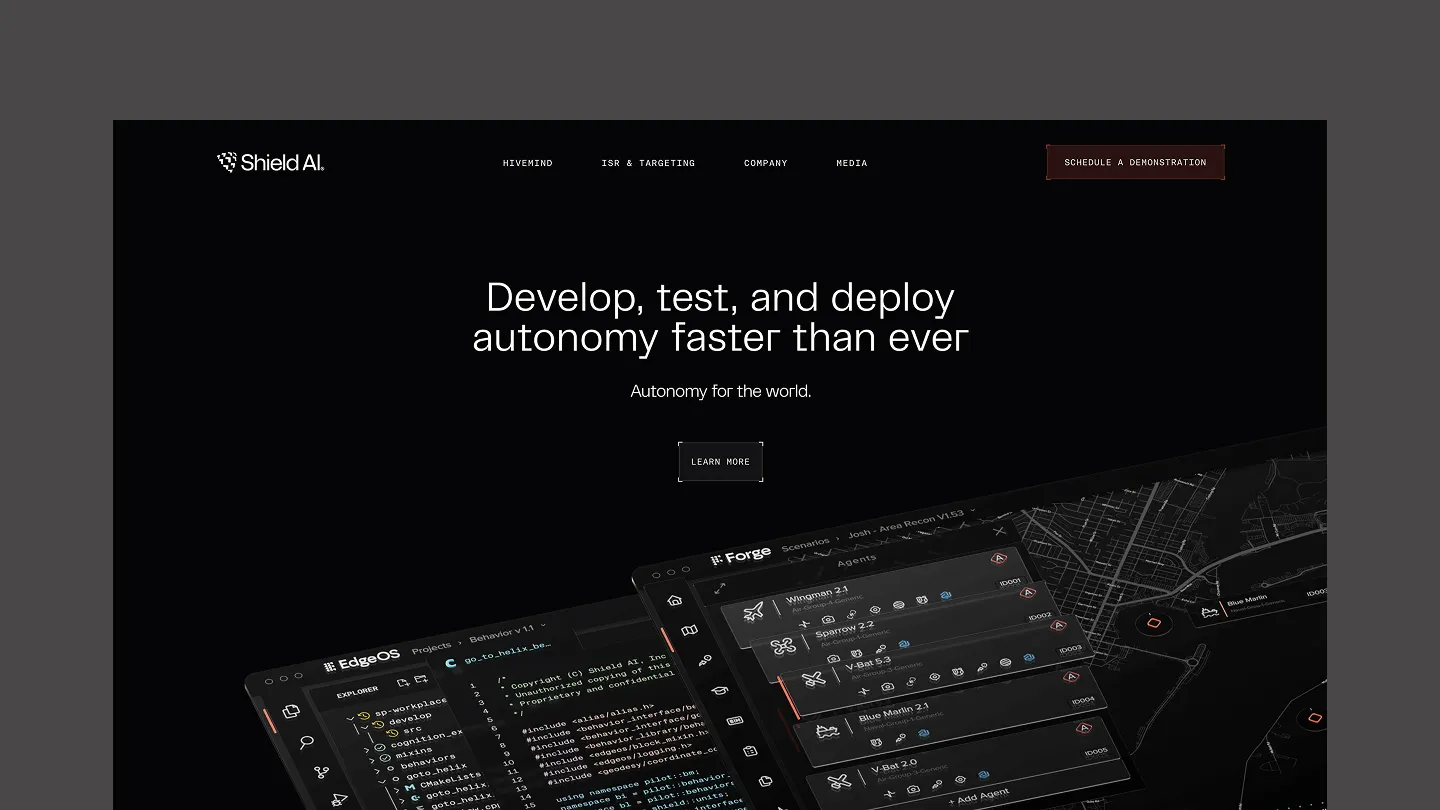
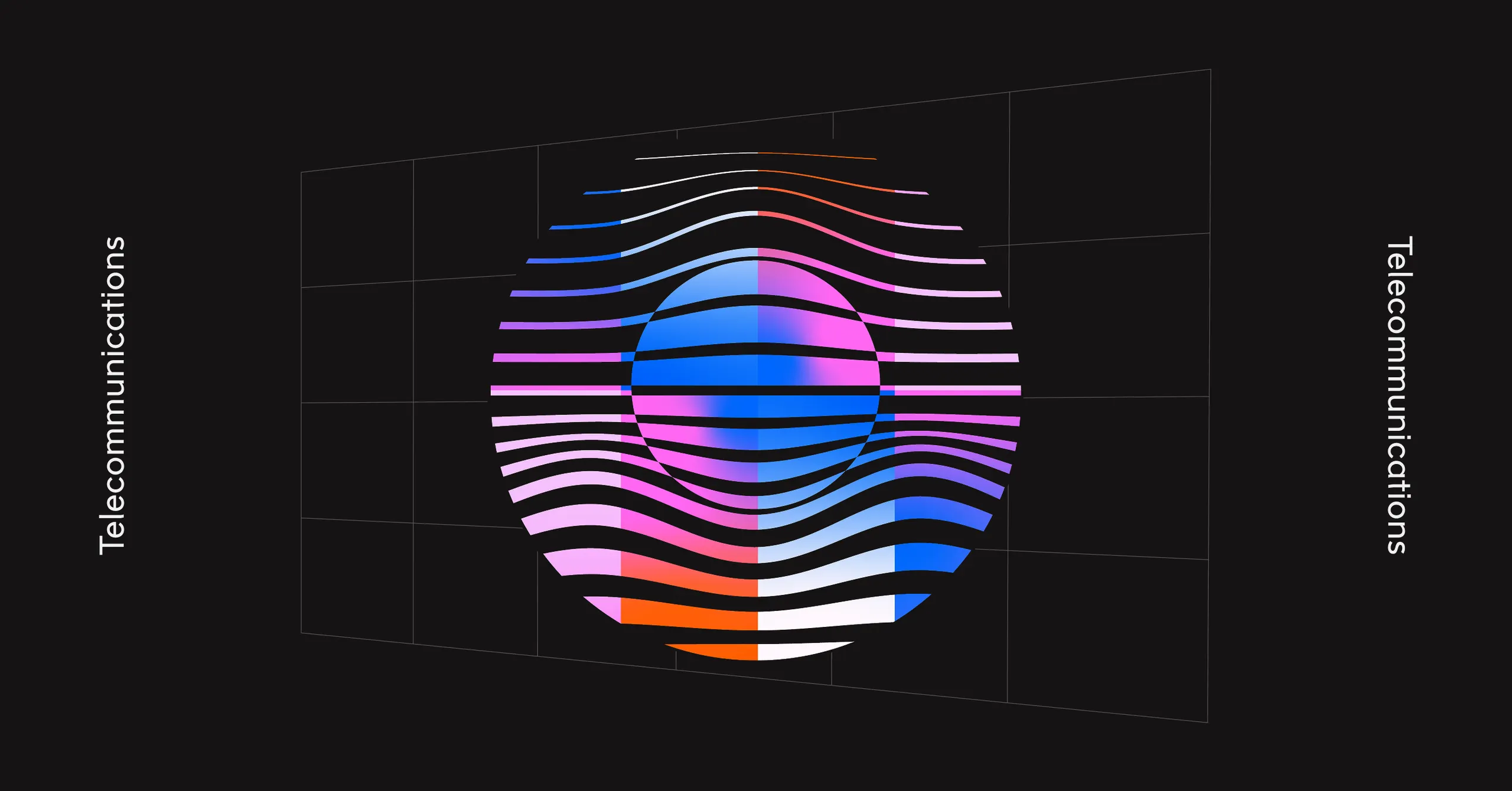
Telecommunications
Overview
Global telecom networks generate over 3,800 terabytes of data per minute — a firehose of real-time signals spanning traffic, performance, topology, and configuration. It’s more than any human team or traditional automation stack can meaningfully process. The sector doesn’t just need analytics — it needs action.
Agentic systems are beginning to deliver exactly that. Vodafone’s SuperTOBi now handles complex customer interactions across Europe, boosting first-time resolution rates by 45%. Other agents are coordinating finance, vendor analysis, and network ops — translating telemetry into action with minimal human involvement.
But scale needs more than skill. A new generation of large telco models (LTMs) — multimodal LLMs trained on real network data — are now being deployed to give agents a domain-native understanding of telecom operations. These LTMs can interpret events, predict failures, recommend actions, and continuously learn from outcomes. Today, 40% of network operators report active AI deployment in planning and operations.
Across the industry, this shift is already underway. SoftBank is using domain-trained models to reconfigure networks in real time, adapting to surges in traffic during mass events without manual intervention.
Elsewhere, companies have built systems that offer a 360-degree operational view, generating automated reports and resolving anomalies before they escalate. BubbleRAN is developing a multi-agent RAN platform that continuously monitors network conditions and reconfigures itself on the fly. And ServiceNow’s agents are diagnosing root causes and generating resolution playbooks before human teams are even looped in.
The trajectory is clear: entire swathes of telecom networks will be run by agents.
Key Applications
Predictive Maintenance & Network Optimisation
Real-Time Customer Support
Fraud Detection & Revenue Assurance
Dynamic Spectrum Management
AI-Augmented Marketing & Personalisation
Self-Healing, Self-Optimising Networks
- £28.28B
- The global ‘AI in Telecommunications’ market by 2032.
- 40%
- Network providers report active AI deployment in planning and operations.
- 84%
- Respondents said that AI is helping increase their company’s annual revenue.
- 80%
- Respondents said that AI is crucial for their company’s future success.
Key Challenges
Data privacy remains the biggest. Telecoms handle sensitive personal data, and with regulations like GDPR in force, AI systems must be transparent, secure, and fully auditable by design.
Legacy infrastructure is another blocker. Many networks still run on outdated backends, limiting the performance and integration of modern AI tools. While agents are adaptable, scalable change depends on deeper modernisation — either through cloud migration or middleware bridges.
There’s also a workforce gap. AI is shifting how telecom teams work, but many lack the tools or training to keep up. Without targeted upskilling, systems go underused or misapplied.
Regulatory pressure is growing too. From algorithmic bias to billing transparency, scrutiny is rising. The response? Systems designed for compliance from the start — explainable, trackable, and safe.
And then there’s capital spend. European telecoms spent €50 billion on capex in 2024 alone, with 5G and fibre rollouts still in full swing. AI can help — from predictive maintenance that cuts unplanned downtime to smarter investment planning based on real-time usage data. But adoption needs to be paired with clear ROI and financial headroom.
“Generative AI is truly revolutionising every single business, every single process, every single procedure.“
Chris PenroseNvidia’s Global Head of Business Development for Telco
The Elsewhen View
High Volume, Low Risk
Telecom has always been defined by complexity — vast networks, legacy systems, and relentless demand. Agentic AI offers a new way through: embedding intelligence directly into the workflows that keep these systems running, optimising, and evolving.
As we have seen, these systems are already in play: automating fault detection, resolving billing queries, coordinating field service, and analysing real-time network data to prevent service disruptions. AI agents are generating resolution playbooks, identifying root causes, and intervening before issues escalate. In customer support, they’re resolving common issues, recommending plan changes, and reducing contact centre load.
New agentic systems are being trained on live network data and deployed in live environments — from infrastructure orchestration to customer experience design — powered by open standards like Model Context Protocol (MCP) and Google’s Agent-to-Agent (A2A) communication, enabling multi-agent coordination across platforms.
The strategic opportunity is expanding too. Some providers are investing in AI infrastructure at a national level, positioning themselves to host sovereign AI services. Others are offering GPU-as-a-Service or exploring commercial models for AI platforms built on their networks. As connectivity margins tighten and compute demand grows, the line between telecom operator and AI infrastructure provider is beginning to blur.
At an organisational level, the playbook is forming: start with high-volume, low-risk tasks where the rules are clear. Then expand into more adaptive, context-aware work. Focus on injecting intelligence into the parts of the business where coordination is most costly — where multiple teams, tools, or decisions have to align in real time.
Who's Doing It? Deutsche Telekom and Google Cloud have partnered to develop RAN Guardian, an agentic system designed to monitor and optimise mobile network performance in real time. Acting autonomously, the agent analyses network behaviour, detects anomalies, and implements corrective actions — reducing latency, boosting reliability, and cutting operational overhead. It marks a meaningful step toward self-healing telecom infrastructure, where intelligent agents play a central role in managing complex, dynamic systems at scale.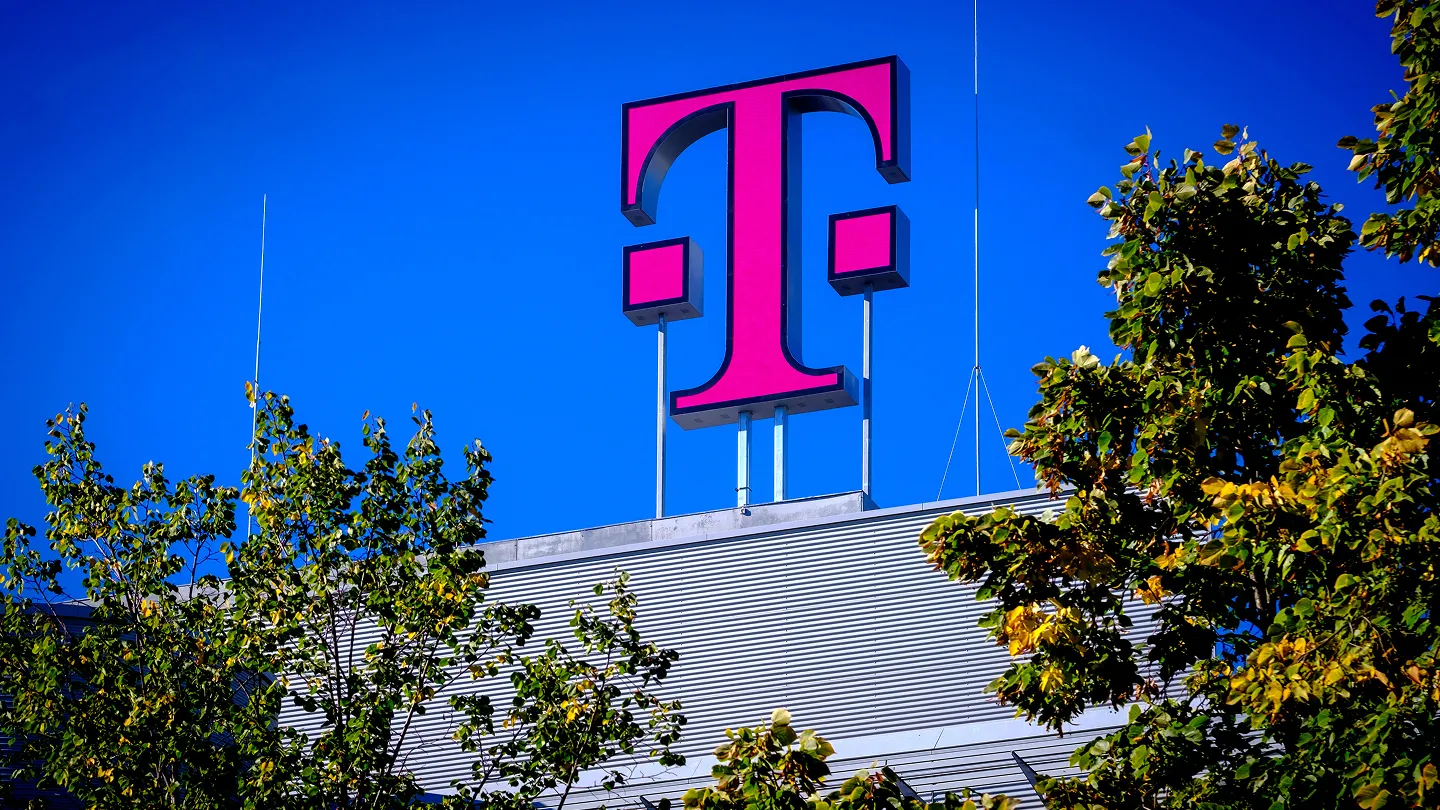
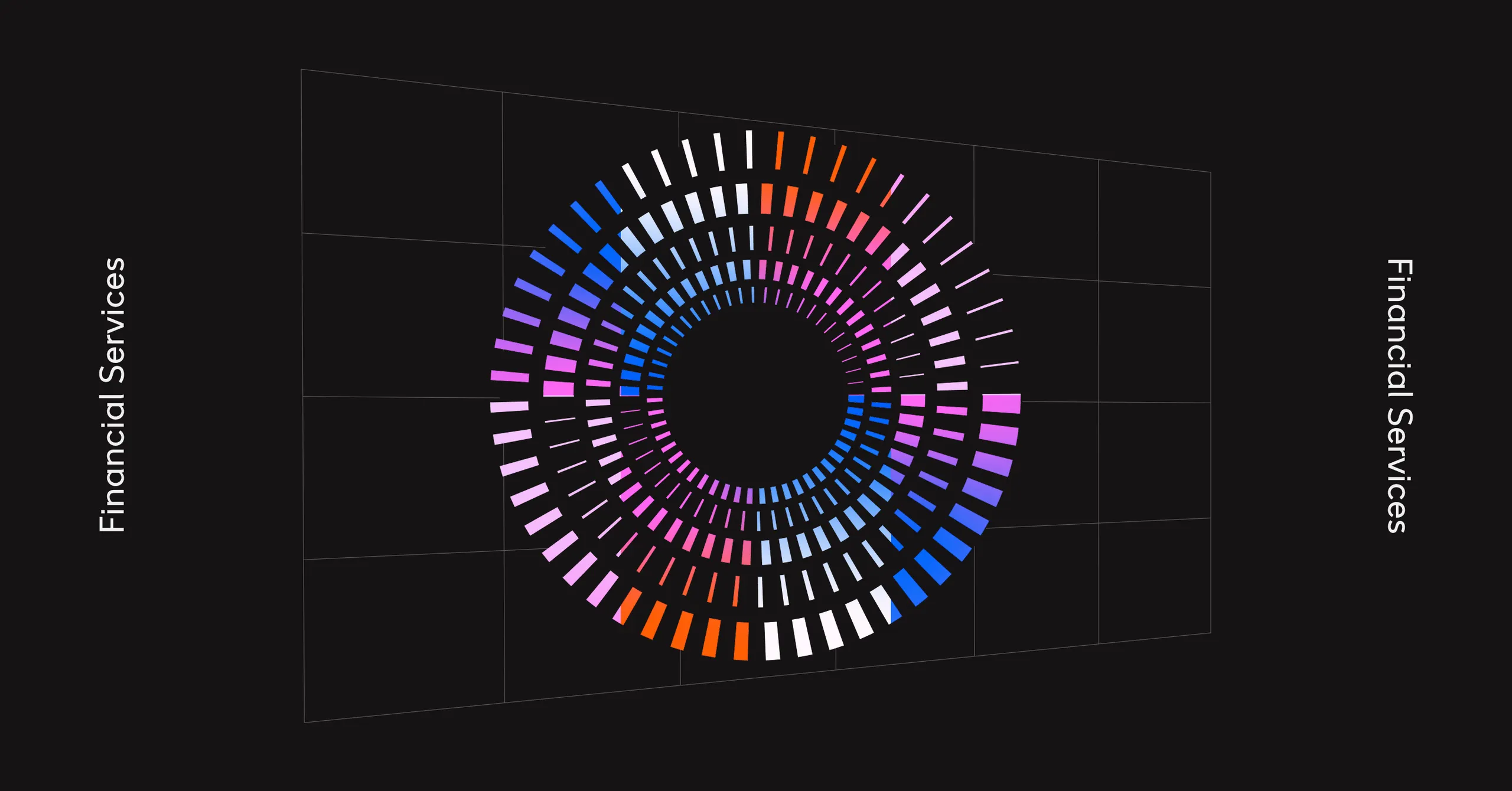
Financial Services
Overview
Financial services are undergoing a profound transformation as AI agents evolve beyond mere automation to take on sophisticated roles in credit scoring, fraud detection, and customer service. But Agentic AI marks a shift from automating tasks to owning outcomes. These systems don’t only assist — they operate. They interpret markets, adjust portfolios, and act in milliseconds. Software no longer has to wait for instruction. Instead, it's intelligence that strategises.
With this in mind, agentic in regards to finance is about systems that operate independently — interpreting context, initiating action, and adapting in real time. In a sector defined by speed, precision, and trust, this shift is tantamount to a structural evolution.
Citibank recently called this the Do-It-For-Me (DIFM) economy — where users don’t just get recommendations, they also get execution. Transactions happen without being told. Portfolios rebalance. Risk is flagged and addressed before it’s seen.
The foundations are already visible. VC funding into agentic finance doubled in 2024, and autonomous systems now handle everything from AML compliance to wealth allocation and synthetic Know Your Customer (KYC). Banks, long the biggest spenders on tech outside of Silicon Valley, are leaning in again — building co-pilots, deploying autonomous agents, and rewriting core workflows around AI.
What’s changing isn’t just what banks do. It’s how intelligence flows — from reactive to proactive, from prompted to pre-emptive. In this new operating system for finance, agentic AI doesn’t assist. It acts.
Key Applications
Credit Risk Assessment
Deepfake and Fraud Detection
Investment and Trading
Customer Service Enhancement
Regulatory Compliance
- #2
- Financial services is now the second-largest consumer of Generative AI, just behind telecom and media. Banks remain the biggest technology spenders outside the tech industry itself.
- 30%
- Productivity boost reported by financial institutions using Generative AI — alongside average revenue growth of 6%.
- £197B
- ‘AI in Finance’ market by 2032 at a 34.3% CAGR.
- £6.3B
- Annual savings delivered by AI-powered chatbots in financial services — by cutting customer service costs by up to 30%.
Key Challenges
The case for agentic AI in finance is strong — but adoption isn’t automatic.
Security and compliance remain non-negotiable. These systems handle sensitive financial data, and must meet the sector’s highest standards for auditability, explainability, and control.
Legacy infrastructure however, doesn’t necessarily need to remain a blocker. With emerging agent capabilities — like Open AI’s ‘Operator Mode’ and Anthropic’s ‘Computer Use’ — AI can now interact with existing software directly, mimicking human workflows to deliver value without replatforming.
The biggest challenges then? Talent, trust, and time. The promise of transformation is real, but proving ROI and scaling beyond pilots demands precision.
That’s why the best implementations start where risk is low and impact is visible — in domains like sales, marketing, and support.
We’re still in the early innings. But the shift has begun — from “assist me” to “do it for me”.
These aren’t reasons to wait. They’re reasons to move carefully — and lead.
"Agentic AI will not directly replace jobs in financial services in the short term. However, it will supercharge employees, and more can be done with less people, leading to less headcount. New roles will of course emerge too."
Huy Nguyen TrieuCo-Founder, Centre For Finance, Technology and Entrepreneurship
The Elsewhen View
Agentification Starts at the Edge
Agentic AI is driving the cost of intelligence toward zero. Real-time risk analysis, hyper-personalised advice — these capabilities are no longer futuristic. They’re becoming expected.
We’re seeing the early signs: Klarna’s agent now handles two-thirds of support queries (though the company has since admitted the quality suffered and is reintroducing humans into the loop). JPMorgan is testing autonomous investment selection. Morgan Stanley is equipping advisors with co-pilots that surface insights on demand. These aren’t fully agentic systems — but once again, the trajectory is clear.
The smart institutions aren’t starting on the trading floor or in compliance. They’re deploying agents in low-risk, high fault-tolerance areas like marketing, sales, and internal ops, where risk is low, feedback is fast, and ROI is provable.
Outside of internal ops, banks are beginning to explore LLM-as-a-Judge systems — using second models to review agent outputs for tone, policy alignment, and consistency with previous communications.
In any case, agentification starts at the edge — with systems that learn, prove value, and earn their way to the core. The advantage will belong to those who recognise it early and act.
Who's Doing It? In January 2025, Powder raised a $5 million seed round to bring generative AI agents into the heart of wealth management operations. Its platform automates the parsing of complex financial and estate documents — a process that typically consumes hours of analyst time. These agents extract key details in seconds, freeing up advisors to focus on client service rather than paperwork. It’s a sharp example of agentic AI applied to a low-risk, high-friction corner of financial services — with immediate ROI.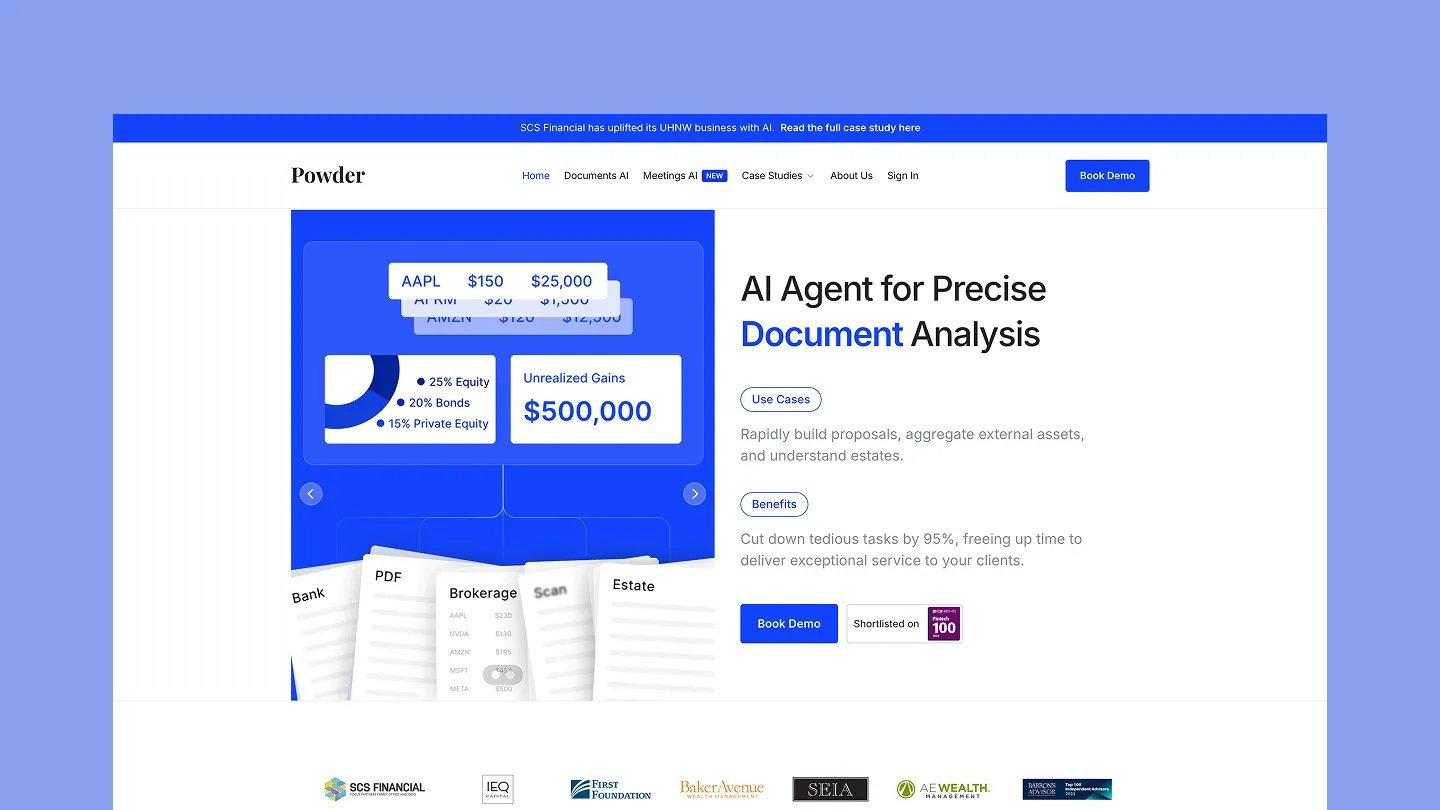
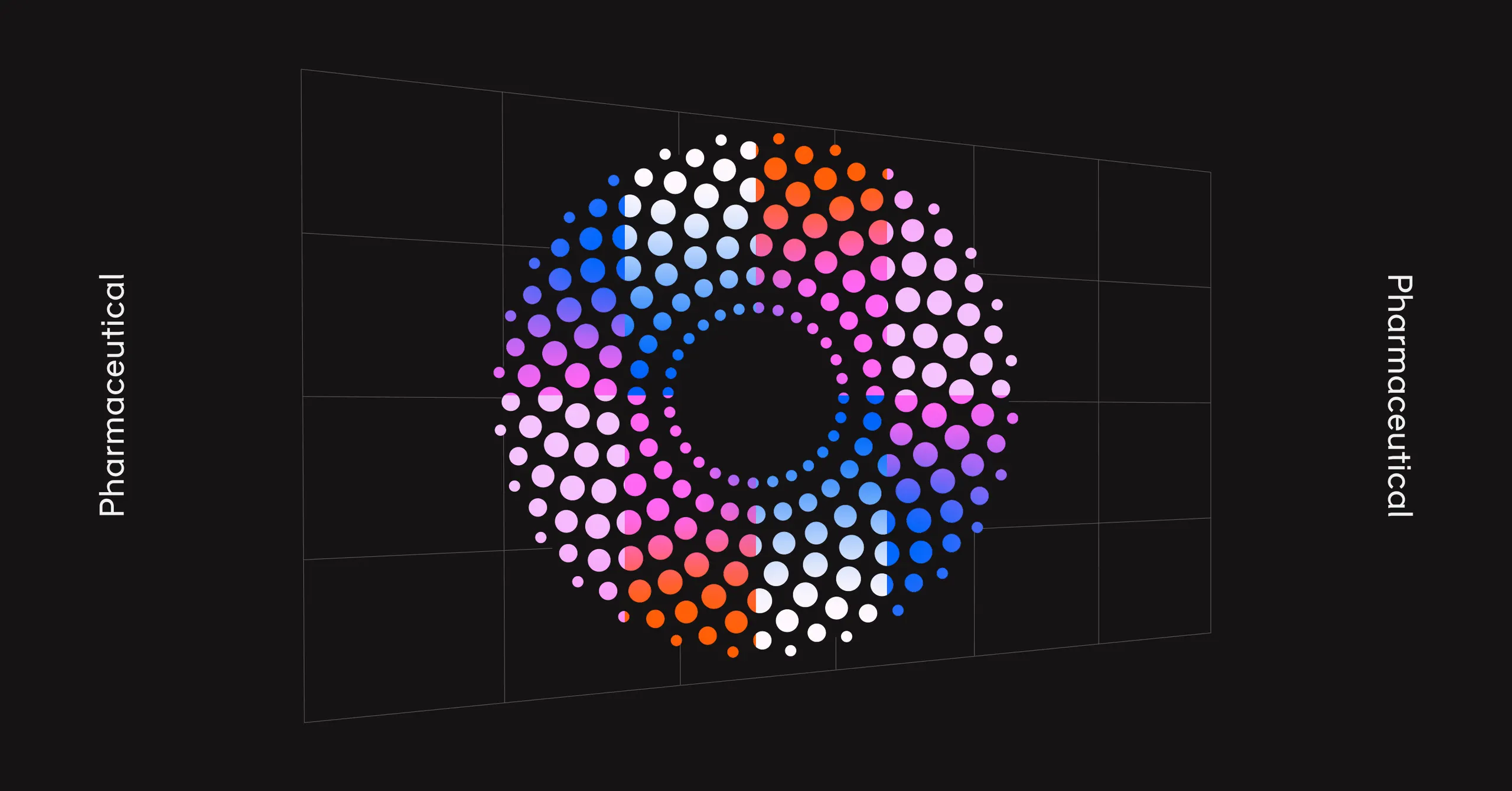
Pharmaceutical
Overview
Pharma is shifting from trial-and-error to precision — and agentic AI is accelerating every stage of the pipeline. With development costs averaging £1.12 billion per drug and 80% tied to clinical trials, the pressure to streamline is massive. AI agents are becoming embedded across discovery, development, and delivery — reducing timelines, cost, and complexity.
At Johnson & Johnson, agents are helping scientists make critical synthesis decisions in drug discovery. One example: managing solvent switches — the moment when one solvent is swapped for another to crystallise a molecule and create the drug. “We’re using agents now to take that content, with all those variables, and figure out, ‘When’s the next time to do that switch and actually execute it?’” explains CIO Jim Swanson. These agents work alongside digital twins and machine learning systems to reduce manual iterations and accelerate outcomes.
Across the industry, AI agents are accelerating clinical development and reducing costs. At Mass General Brigham, a generative AI model screened nearly 1,900 patients for a heart failure trial with up to 100% accuracy — outperforming trained staff with up to 100% accuracy, at just 11 cents per patient. Clinical trial co-pilots like these are cutting enrollment times, reducing human error, and unlocking major gains in patient targeting and operational efficiency.
The upside is significant. Some estimates suggest generative AI could unlock £10.3–19.8 billion in R&D value alone. AI is now embedded across the R&D pipeline, influencing decisions from early discovery to late-stage development.
Key Applications
Accelerated Drug Discovery
Streamlined Clinical Trials
Personalised Medicine & Biomarker Identification
Pharmaceutical Supply Chain Optimisation
AI-Driven Regulatory & Compliance Monitoring
Generative Compound Design & Lead Optimisation
- £19.8B
- Generative AI could unlock in R&D value.
- 80%
- Pharmaceutical professionals are using AI for drug discovery.
- 50%
- Cost reductions by streamlining clinical trial processes and auto-drafting trial documents.
- 75%
- Of leading healthcare companies are experimenting with or planning to scale generative AI across their enterprises.
Key Challenges
Data remains the first constraint. Models require enormous volumes of high-quality clinical and genomic information, yet much of the industry’s data remains fragmented, siloed, or poorly labelled.
Even when the data is clean, the regulatory path is not. Black-box systems struggle to pass approval where explainability is a legal requirement. Ethical concerns around algorithmic bias, patient privacy, and access inequalities continue to shadow AI’s more optimistic narratives — especially as agents begin to influence trial design and therapeutic decisions.
Then there’s the issue of fit. Many pharma companies still rely on legacy infrastructure, where integrating modern AI agents is more patchwork than platform. Without dedicated middleware or system modernisation, agentic potential stays theoretical. At the same time, there’s a human gap. The demand for talent that bridges AI and biomedical science outpaces supply, slowing the ability to deploy and maintain agent-led systems at scale.
And beneath it all is the constant pressure to show value fast. In a high-stakes, long-cycle industry, few companies have the luxury of speculative innovation. Agents that can’t prove time-to-value — or adapt as the field evolves — risk becoming just another sunk cost.
And beneath it all is the constant pressure to show value fast. In a high-stakes, long-cycle industry, few companies have the luxury of speculative innovation. Agents that can’t prove time-to-value — or adapt as the field evolves — risk becoming just another sunk cost.
“The agent isn't wedded to the project for the last 10 years. The agent is dispassionately saying: 'Don't go forward or go forward faster, or go forward and remember these things.'”
Paul HudsonCEO, Sanofi
The Elsewhen View
A Golden Age of Medicine
Drug discovery has always been a slow race against time. Agentic AI changes the pace. Not by replacing scientists, but by restructuring the scientific process itself. We’re moving from static pipelines to learning loops — systems where data from the lab feeds models, which generate predictions, which in turn shape new experiments. That data returns to retrain the models. It’s not trial and error. It’s trial and iteration.
But the model is only part of the story. In pharmaceuticals, where regulation is complex and data deeply contextual, foundation models account for just 15% of the real work. The real advantage lies in how well you shape that model to your environment — grounding it in proprietary data through Retrieval Augmented Generation (RAG), integrating it into workflows, and adapting it to the subtle edge cases that define science at scale.
This is where agentic systems excel — managing complexity, accelerating feedback cycles, and coordinating across disciplines that would otherwise operate in silos. But they demand more than algorithms. They require trust. Designing for that trust — across interfaces, workflows, and governance — is as critical as the models themselves.
Privacy must be engineered into every layer. Transparency can’t be an afterthought. And agents must be deployed first in high-value, low-risk contexts — surfacing biomarkers, streamlining documentation, automating supply chains — before they begin steering clinical decisions.
However, when all is said and done, we’re not just accelerating processes. We’re entering a golden age of medicine.
Who's Doing It? A sister company to DeepMind, Isomorphic Labs secured $600 million in March 2025 to expand its AI-first approach to drug discovery. Built on AlphaFold’s breakthrough protein-structure prediction capabilities, Isomorphic applies agentic reasoning and simulation to identify promising compounds, optimise drug candidates, and accelerate preclinical workflows. With its first AI-designed drugs expected to enter clinical trials by late 2025, the company aims to compress what was once a decade-long R&D cycle into something far more tractable — making autonomous scientific discovery a tangible reality.
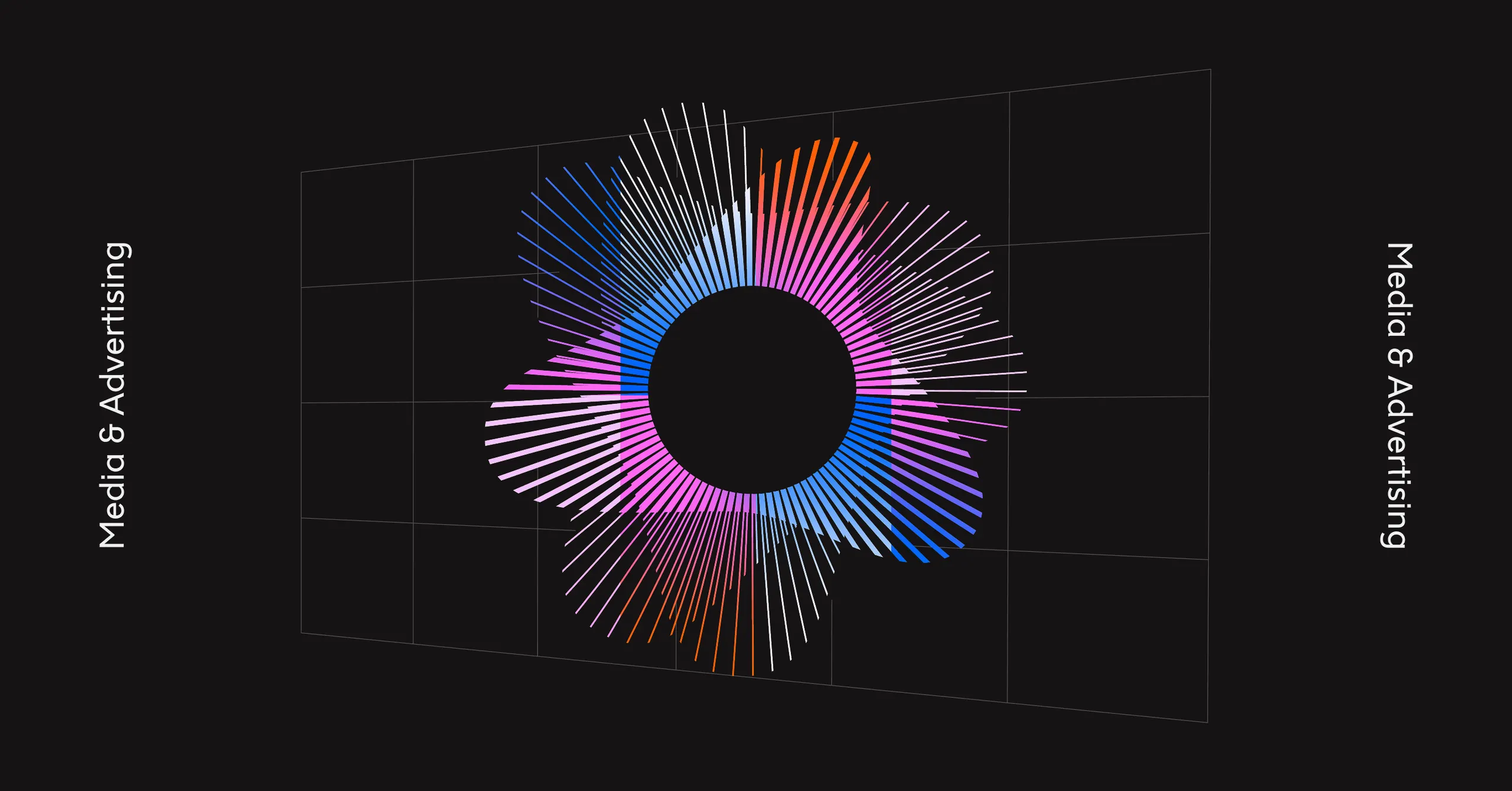
Media & Advertising
Overview
Media and advertising are now leveraging autonomous AI agents to create, test, and optimise campaigns in real time. In real-time bidding, they’re now evaluating every impression, making optimisations without human intervention. Creative is being generated, tested, and refined in minutes, not days.
One firm, for example, has deployed agents that replicate the work of junior media buyers across Google, Meta, and Amazon — cutting campaign launch times by 65%, and improving performance by 30%. What used to take thirty people, now takes four.
This shift isn’t just operational. It’s structural. Publishers are adapting their business models, with 72% now using AI in content creation or distribution — up from just 28% at the start of 2024.
That same adaptive mindset is now moving into market research. WPP Open, for example, allows brands to encode marketing personas into AI systems, turning audience insights into real-time feedback loops. Teams can upload an ad and get instant, simulated responses from specific demographics — like Gen Z males — based on defined traits and behaviours. These synthetic personas evolve over time, supporting rapid iteration and sharper targeting.
While not all of these systems are not yet fully agentic, they represent a meaningful extension of the toolbox — expanding what media and advertising teams can test, how fast they can do it, and how closely those tests approximate live feedback.
Key Applications
Real-Time Bidding Optimisation
Dynamic Creative Optimisation (DCO)
Predictive Audience Targeting
Synthetic Personas & Segmentation
Continuous Campaign Optimisation
Real-Time Fraud Detection & Prevention
- £217.33B
- Projected ‘AI in Marketing’ market size value by 2034.
- 56%
- Marketers say their company is taking an active role in implementing and using AI.
- 51%
- Marketers use AI tools to optimise content, from email campaigns to search engine.
- 75%
- Companies currently investing in AI technology are looking to move their talent into more strategic roles this year and beyond.
Key Challenges
Agentic AI in Media & Advertising brings power, but also pressure. The biggest hurdle is privacy: as systems learn from user behaviour, they must remain compliant in a cookieless, consent-driven world. Transparency isn’t optional — it’s a requirement.
Creative integrity is another concern. Generative ads can scale endlessly, but without tight guidance, they risk becoming incoherent or off-brand. Brands need agents that elevate campaigns, not flood them with noise.
Then there’s bias in audience modelling. Synthetic personas, if trained poorly, can reinforce stereotypes or miss nuance — limiting reach and repeating old mistakes.
And finally, trust. As agents act independently across platforms, the logic behind decisions becomes harder to trace. Without visibility, confidence erodes.
“When we look back at this event years from now, you’re going to remember it as the year of AI agents.”
Dharmesh ShahHubSpot co-founder and CTO
The Elsewhen View
Hyperpersonalisation at Scale
The future of programmatic advertising isn’t about more automation — it’s about better orchestration. When implemented with care, agentic AI enables campaigns that are not just targeted, but trusted.
We believe in using agents not to flood the funnel, but to finesse it — turning data into dialogue and reach into resonance. This is hyperpersonalisation at scale: dynamic, contextual, and brand-consistent. It means agents that cohere to brand tone, adapt to audience signals in real time, and know when to escalate or yield. That includes interpreting sentiment — not just tracking engagement, but understanding tone, emotion, and intent — so agents can respond with nuance, not noise.
Start with low-risk, high-reward environments: dynamic creative testing, synthetic audience segmentation, real-time bidding strategies. These are the proving grounds — where agents can learn to interpret response patterns, fine-tune messaging, and adjust strategy based on sentiment in motion.
Across marketing functions agentic systems can be used to optimise outputs and sharpen strategy.
Who’s Doing It? WPP is integrating agentic AI across its global operations through WPP Open, a unified marketing operating system now used by over 41,000 employees. With $400 million allocated annually to AI and technology, the company has developed over 28,000 custom AI agents to support everything from media planning and creative development to pricing and performance optimisation.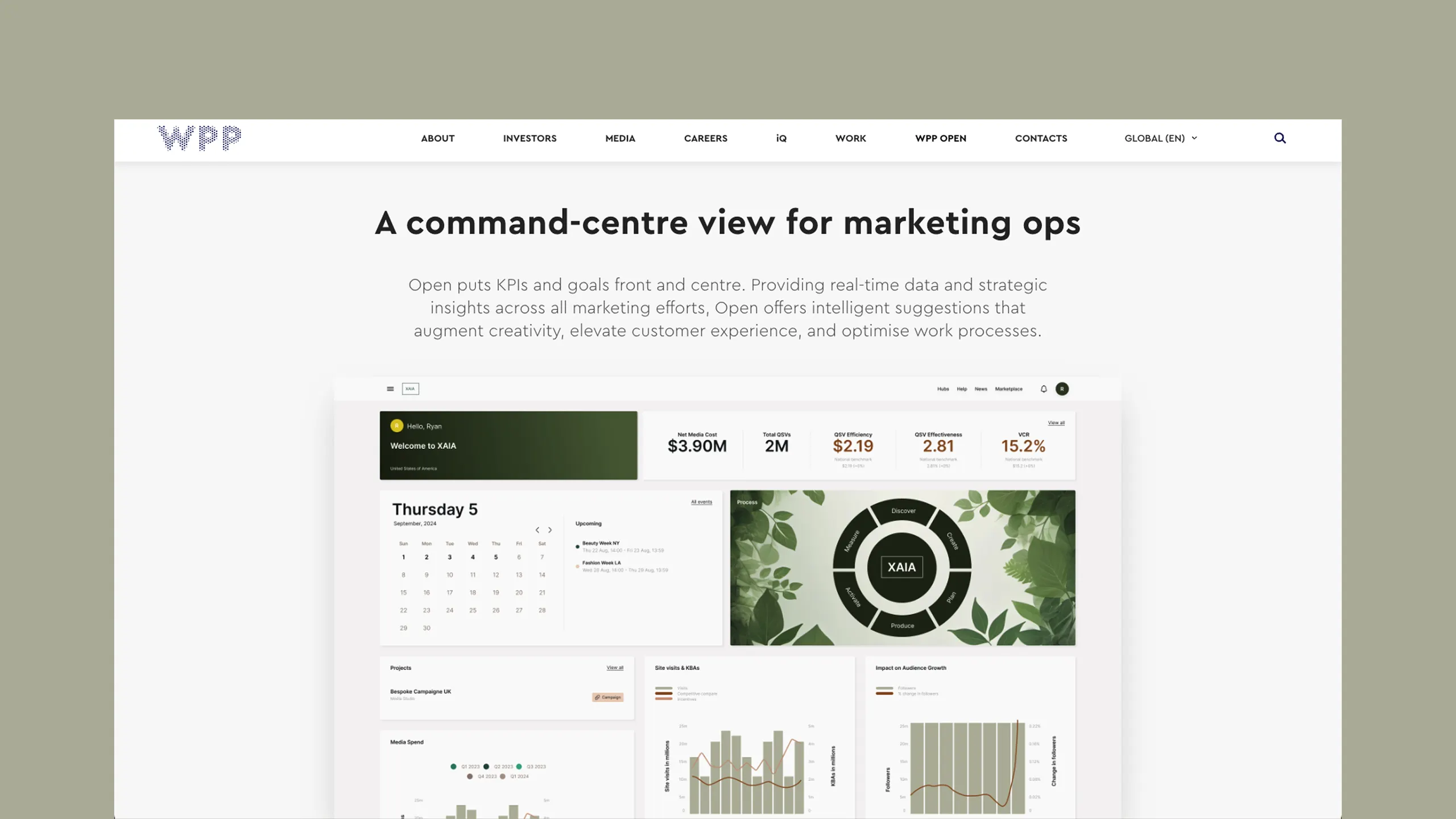
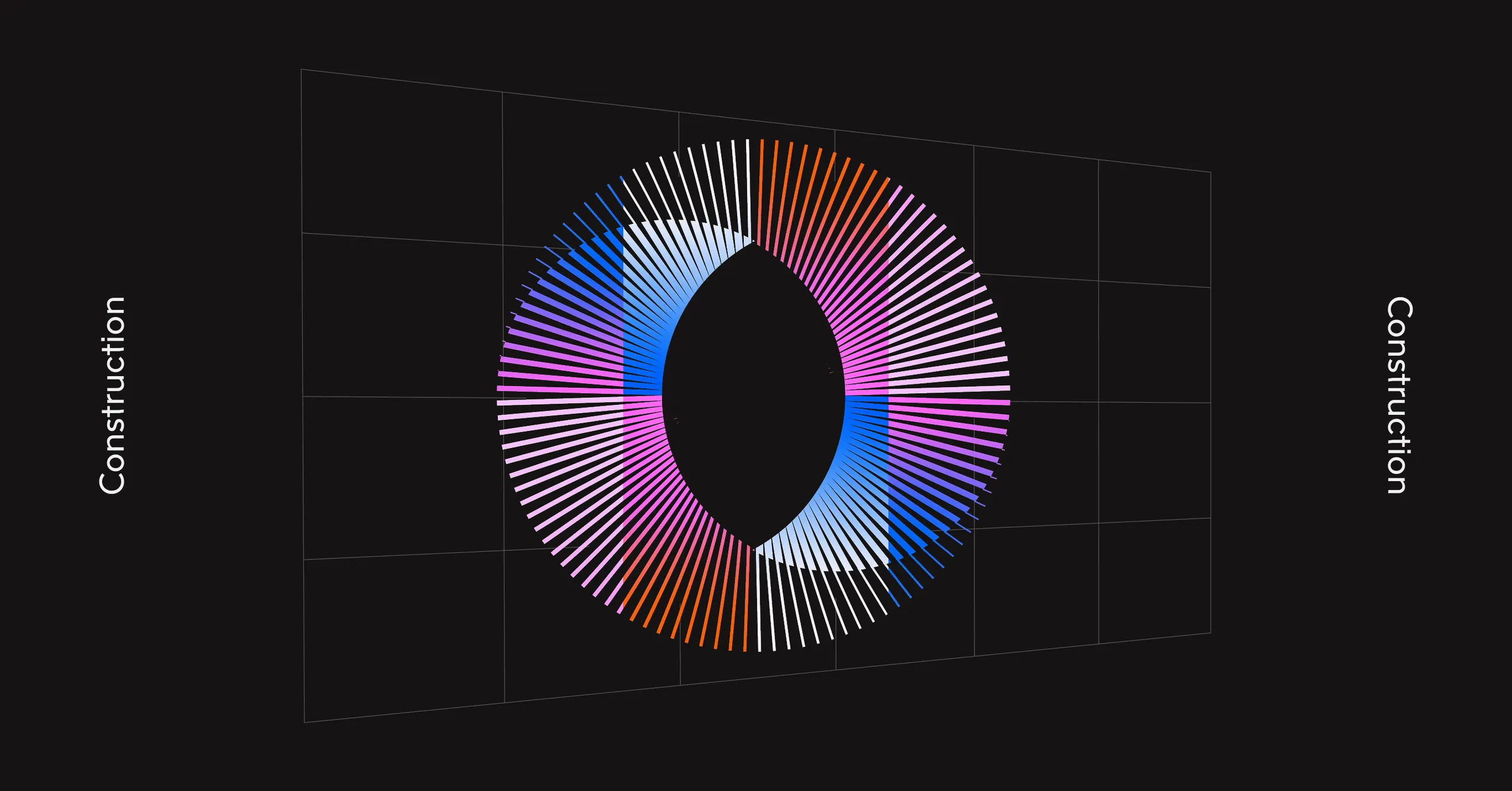
Construction
Overview
Construction is entering its agentic era. Long reliant on manual workflows, legacy systems, and static digital tools like Building Information Modelling (BIM), the industry is now being redefined by intelligent systems that don’t just support decisions — they make them.
From invoice processing to on-site safety, AI agents are embedding themselves into daily operations. Cork Howard uses Billy the Bot to streamline financial workflows and cut down manual invoice tracking. Balfour Beatty meanwhile is in the process of developing StoaOne, a large language model generative AI assistant that will help employees mine what Kasey Bevans, Balfour Beatty US chief information officer, calls “untold billions of data points”.
In 2024, Turner Construction reduced delays by 30% through risk prediction tools — a sign of how intelligent systems are evolving from assistive analytics toward more autonomous, agentic models. On-site, computer vision now monitors compliance and enforces safety protocols in real time. In a sector grappling with labour shortages, rising sustainability demands, and chronic overruns, these systems are no longer a novelty: they’re fast becoming the backbone of a new operational model — one defined by greater precision, efficiency, and safety across the job site.
Key Applications
Predictive Risk Management
Generative Design & Planning
Autonomous Project Monitoring
Proactive Equipment Maintenance
AI-Driven Safety Protocols
- £17.95B
- The expected global “AI in Construction” market by 2032.
- 36%
- EHS professionals believe generative AI could enhance the quality and speed of safety submissions.
- 76%
- Senior industry decision-makers at large UK firms have high expectations for the use of AI in construction.
- 40%
- Reduction in construction project timelines achievable through the use of AI and automation technologies.
Key Challenges
The promise of agentic AI in construction is real, but so are the constraints. Much of the sector still operates on fragmented or incomplete data, and when predictions depend on perception, that’s a problem. Inconsistent data inputs can compromise model accuracy — especially in safety, logistics, and site monitoring.
Upfront costs remain a hurdle, too. Deploying drones, wearables, and AI-integrated hardware carries a price tag many smaller firms can’t yet justify. A four-camera system would cost about £2,500 and a two-camera set-up would be priced at around £1,700, according to Construction News. Even as long-term ROI becomes clear, the initial investment slows adoption at scale.
Then there’s the human element. The construction workforce — often hands-on and time-poor — can be resistant to change. AI systems that feel imposed rather than integrated face pushback, especially when tied to job security concerns.
Ultimately, adoption depends not on raw capability, but on thoughtful deployment — bringing AI into the field in ways that augment, not alienate. That means building trust, ensuring transparency, and designing systems that work with, not just for, the people on site.
"Worker safety is paramount… AI proactively assesses hazards in real time via computer vision tools and wearable technologies.”
Wes CollinsAssociate Professor at Auburn University’s McWhorter School of Building Science
The Elsewhen View
From Augmentation to Acceleration
Construction is awash with fragmented data — from BIM models and delivery schedules to safety logs and supplier updates. Agentic systems consolidate that complexity through RAG (Retrieval-Augmented Generation), pulling the right information at the right time to inform action, not just analysis.
Agentic AI offers decision-makers that don’t clock off — systems that monitor, assess, and adapt in real time across unpredictable environments. But this is about more than intelligence, it’s about integration.
True transformation happens when agents don’t sit above workflows, but inside them — embedded across supply chains, equipment systems, and safety protocols. Whether it’s drones cross-checking progress or predictive maintenance agents minimising downtime, the goal is the same: reduce friction, increase flow.
For firms hesitant about AI’s cost, the answer isn’t to wait — it’s to start smaller. Focus on low-risk, high-reward use cases like site monitoring or logistics orchestration. You don’t modernise the job site by swapping out the scaffolding all at once. You do it by proving the value of augmentation — then scaling it.
And as adoption grows, so too must resilience. That means secure data layers, transparent models, and systems designed not to replace human judgment, but to extend it — hour by hour, brick by brick.
Who’s Doing It Construction giants like Balfour Beatty, Skanska, Gilbane, and Turner are now racing to embed agentic systems into daily operations. Balfour Beatty’s StoaOne and Skanska’s Sidekick are internal generative AI assistants trained on project data, helping teams query specifications and surface insights in seconds. Gilbane is already deploying tools like Trunk Tools to track tens of thousands of documents on major builds. Meanwhile, Turner has tripled its AI investment in the last two years, with in-house teams integrating foundation models like Gemini and Claude into their project ecosystems.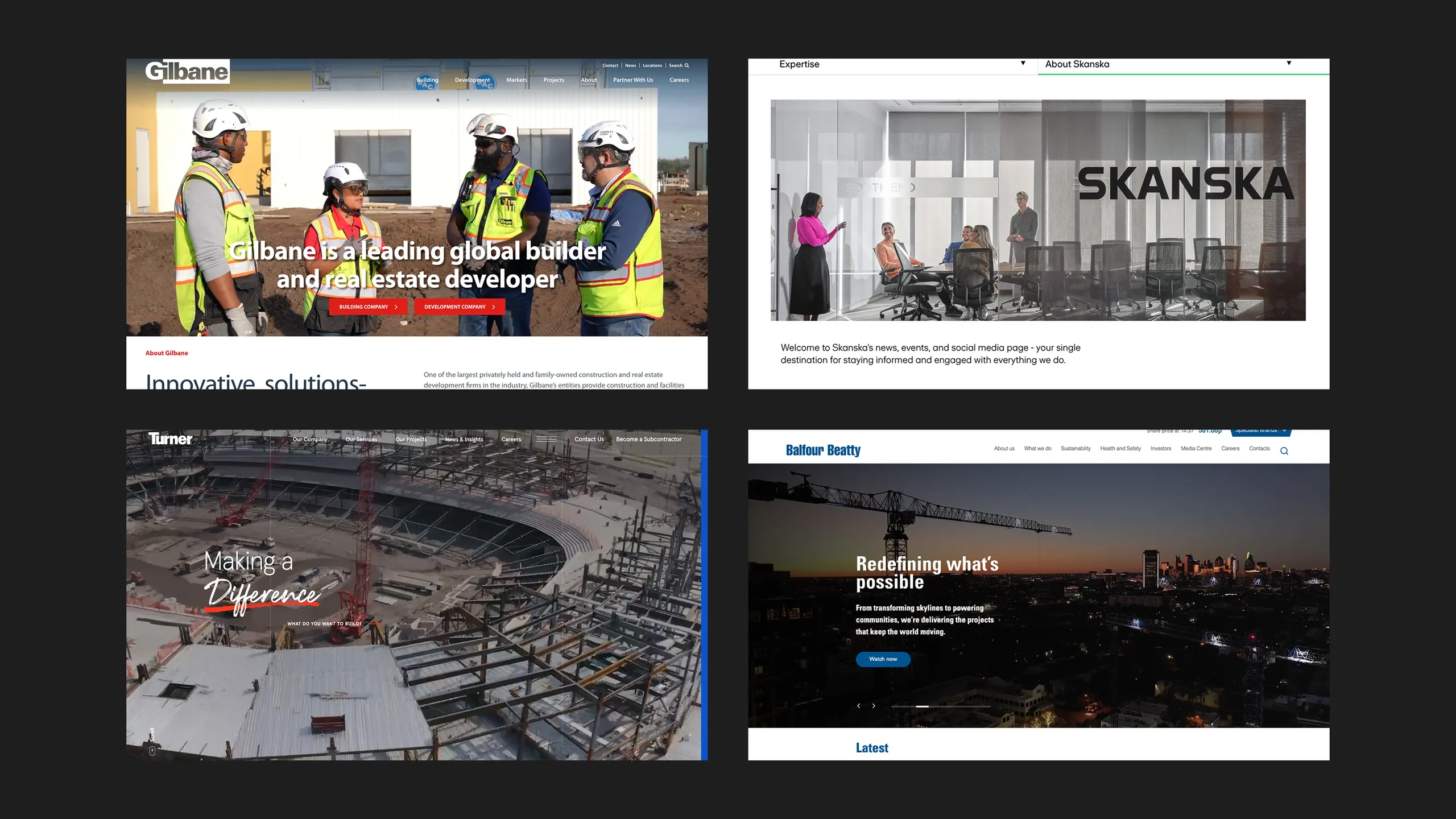
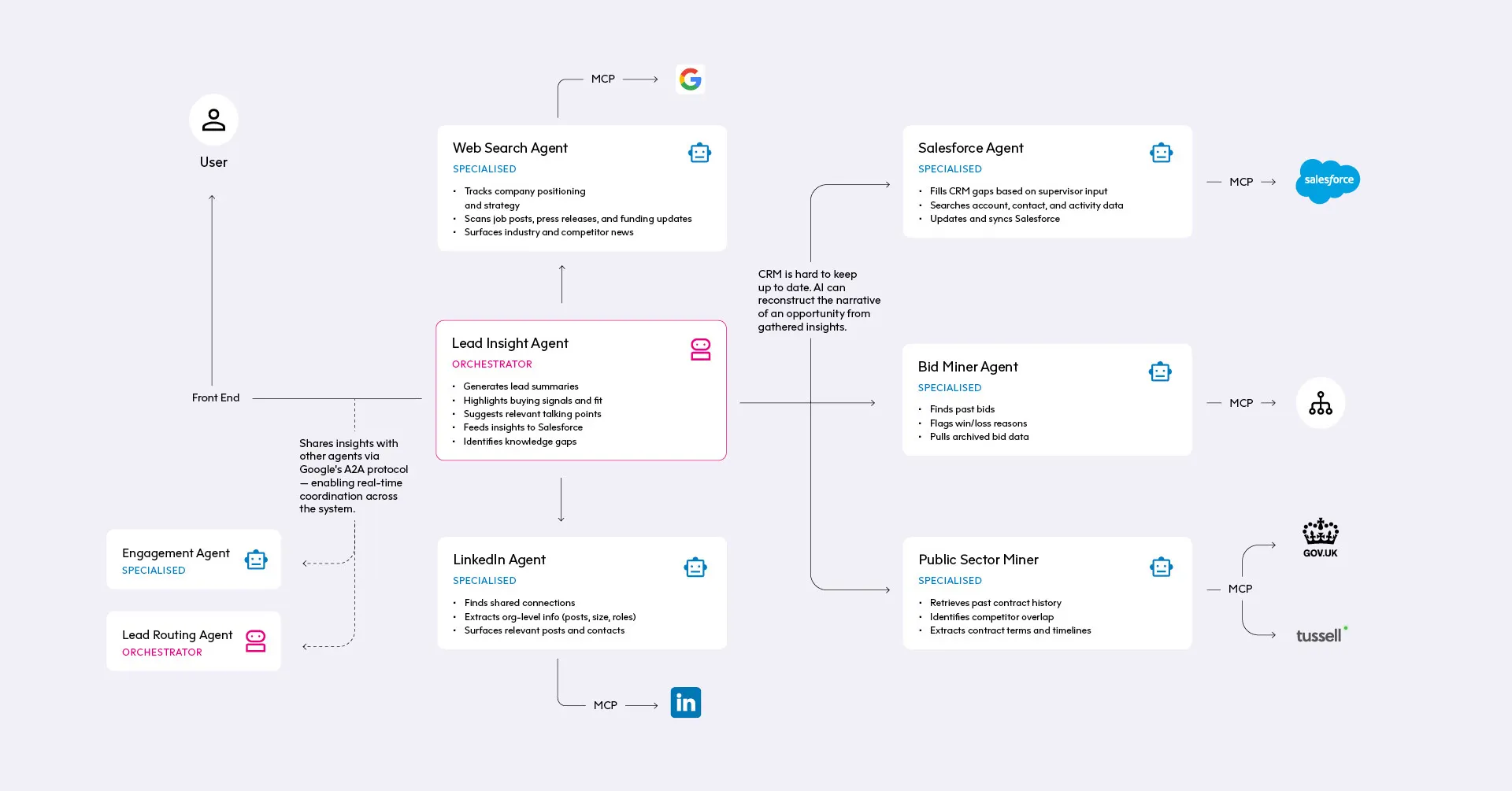
Emerging Patterns
Across industries the one connective tissue between agentic systems is their commercial proving ground: marketing and sales. These are domains where data is abundant, decisions are repeatable, and latency matters — but the operational risk is low. It’s here that agentic systems can be deployed safely, measured meaningfully, and iterated quickly.
That’s why many of the multi-agent systems we’ve built for FTSE10 clients have started here. From lead qualification and bid intelligence to personalised outbound and pipeline orchestration, these agentic architectures are delivering compound returns without needing to touch core systems or regulated infrastructure. They prove value at the edge and then earn their way inward.
What makes this viable now is the emergence of shared protocols. Anthropic’s Model Context Protocol (MCP) and Google’s Agent2Agent (A2A) standard have created a throughway for agents to operate across tools, vendors, and contexts. They enable real coordination — not just task automation — and are laying the groundwork for systems that think and act in concert.
